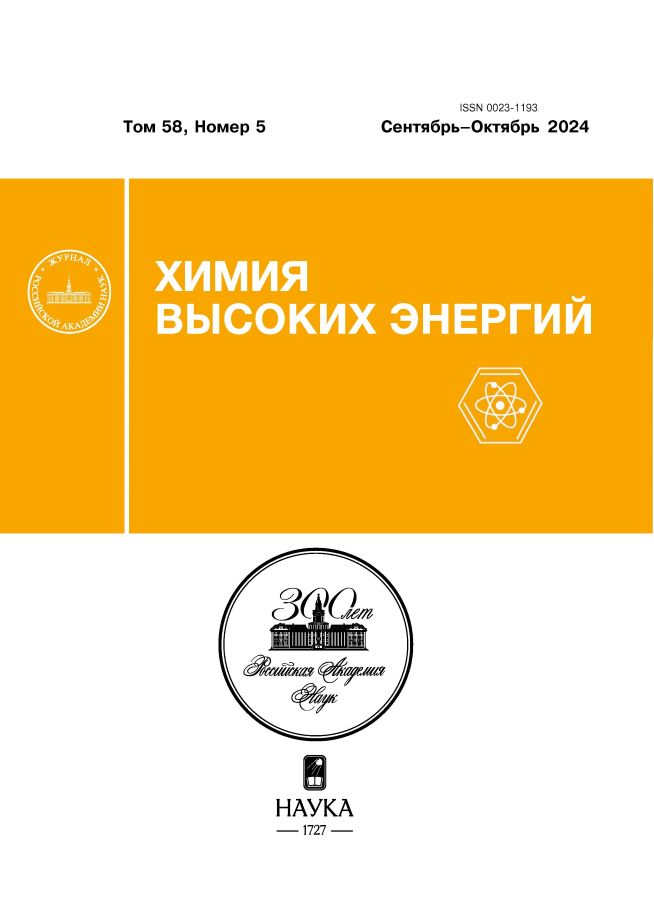Radiolytic degradation of ethylene glycol and glycerol in aqueous solutions
- Authors: Kholodkova E.M.1, Popova A.V.1, Artamonova K.A.1, Ponomarev A.V.1
-
Affiliations:
- Frumkin Institute of Physical Chemistry and Electrochemistry, Russian Academy of Sciences
- Issue: Vol 58, No 5 (2024)
- Pages: 391-396
- Section: RADIATION CHEMISTRY
- URL: https://permmedjournal.ru/0023-1193/article/view/684846
- DOI: https://doi.org/10.31857/S0023119324050073
- EDN: https://elibrary.ru/TXQOZX
- ID: 684846
Cite item
Abstract
The influence of absorbed dose (up to 90 kGy) and the initial concentrations of ethylene glycol and glycerol (from 30 to 250 mg / L) on their degradation in aqueous solutions under a 3–MeV electron beam has been studied. Aeration of the solutions during irradiation decreased the yield of degradation. In the absence of aeration, the observed initial yields of degradation were about 0.23 μmol / J for ethylene glycol and about 0.14 μmol / J for glycerol. Degradation products formed in aqueous solutions are more resistant to ionizing radiation compared to the parent alcohols. A simultaneous reduction in alcohol concentration and chemical oxygen demand (COD) to standard values was achieved in solutions with an initial concentration of 30–40 mg / L at a dose of no higher than 2–3 kGy.
Full Text
About the authors
E. M. Kholodkova
Frumkin Institute of Physical Chemistry and Electrochemistry, Russian Academy of Sciences
Email: ponomarev@ipc.rssi.ru
Russian Federation, Moscow
A. V. Popova
Frumkin Institute of Physical Chemistry and Electrochemistry, Russian Academy of Sciences
Email: ponomarev@ipc.rssi.ru
Russian Federation, Moscow
K. A. Artamonova
Frumkin Institute of Physical Chemistry and Electrochemistry, Russian Academy of Sciences
Email: ponomarev@ipc.rssi.ru
Russian Federation, Moscow
A. V. Ponomarev
Frumkin Institute of Physical Chemistry and Electrochemistry, Russian Academy of Sciences
Author for correspondence.
Email: ponomarev@ipc.rssi.ru
Russian Federation, Moscow
References
- Rebsdat S., Mayer D. Ethylene Glycol. Ullmann’s Encyclopedia of Industrial Chemistry. Wiley, 2000.
- Christoph R., Schmid, B., Steinberner U., Dilla W., Karinen R. Glycerol. Ullmann’s Encyclopedia of Industrial Chemistry. Wiley, 2006.
- Hilles A.H., Abu Amr S.S., Aziz H.A., Bashir M.J.K. // Advanced Oxidation Processes for Water and Wastewater Treatment. London: IWA Publishing, 2019. Р. 46–69.
- Ponomarev A.V., Ershov B.G. // Environmental Science and Technology. 2020. V. 54. P. 5331–5344.
- Nepachalovich P.S., Shadyro O.I., Bekish A.V., Shmanai V.V. // Free Radic. Res. 2020. V. 54. P. 732–744.
- Pikaev A.K., Kartasheva L.I. // Int.J. Radiat. Phys. Chem. 1975. V. 7. P. 395–415.
- Ponomarev A.V., Vlasov S.I., Kholodkova E.M. // High Energy Chemistry. 2019. V. 53. P. 314–320.
- Lutova Z.B., Panasyuk S.L., Yudin I.V. // Bull. Saint Petersbg. State Inst. Technol. 2019. P. 18–24.
- Plant A.G., Kos B., Jazbec A., Snoj L., Joyce M.J., Najdanovic-Visak V. // Ind.Eng. Chem. Res. 2023. V. 62. P. 21152–21163.
- Plan A.G., Kos B., Jazbec A., Snoj L., Najdanovic-Visak V., Joyce M.J. // Commun. Chem. 2021. V. 4. P. 132.
- Kholodkova E.M., Ponomarev A.V. // High Energy Chem. 2023. V. 57. P. 146–150.
- Ponomarev A.V. // Radiation Physics and Chemistry. 2020. V. 172. P. 108812.
Supplementary files















